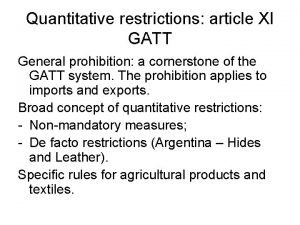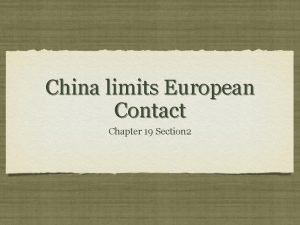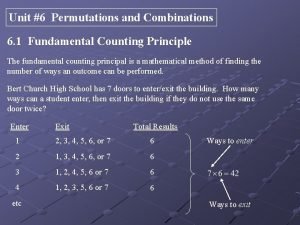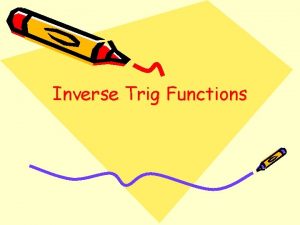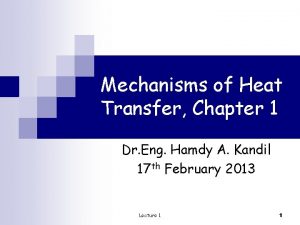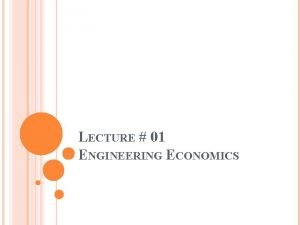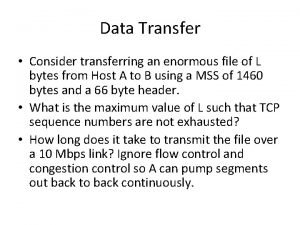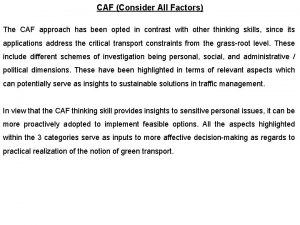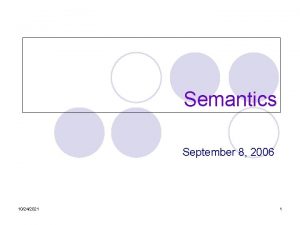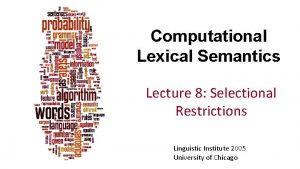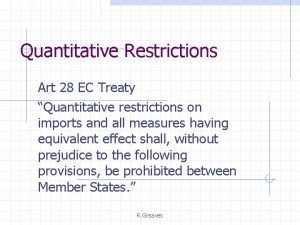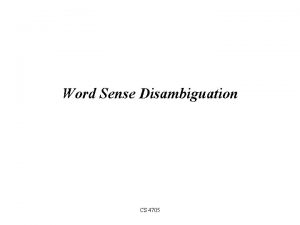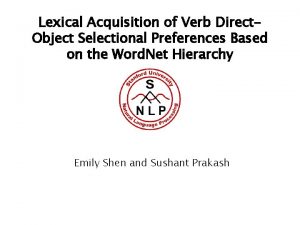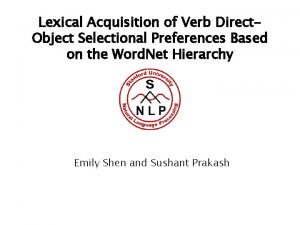Selectional Restrictions Selectional Restrictions Introduction Selectional Restrictions Consider

















- Slides: 17

Selectional Restrictions

Selectional Restrictions Introduction

Selectional Restrictions Consider the two interpretations of: I want to eat someplace nearby. a) sensible: Eat is intransitive and “someplace nearby” is a location adjunct b) Speaker is Godzilla Eat is transitive and “someplace nearby” is a direct object How do we know speaker didn’t mean b) ? Because the THEME of eating tends to be something edible 3

Selectional restrictions are associated with senses • The restaurant serves green-lipped mussels. • THEME is some kind of food • Which airlines serve Denver? • THEME is an appropriate location 4

Selectional restrictions vary in specificity I often ask the musicians to imagine a tennis game. To diagonalize a matrix is to find its eigenvalues. Radon is an odorless gas that can’t be detected by human senses. 5

Representing selectional restrictions Instead of representing “eat” as: Just add: And “eat a hamburger” becomes 6 But this assumes we have a large knowledge base of facts about edible things and hamburgers and whatnot.

Let’s use Word. Net synsets to specify selectional restrictions • The THEME of eat must be Word. Net synset {food, nutrient} “any substance that can be metabolized by an animal to give energy and build tissue” • Similarly THEME of imagine: synset {entity} THEME of lift: synset {physical entity} THEME of diagonalize: synset {matrix} • This allows imagine a hamburger and lift a hamburger, • Correctly rules out 7 diagonalize a hamburger.

Selectional Restrictions Selectional Preferences

Selectional Preferences • In early implementations, selectional restrictions were strict constraints (Katz and Fodor 1963) • Eat [+FOOD] • But it was quickly realized selectional constraints are really preferences (Wilks 1975) • But it fell apart in 1931, perhaps because people realized you can’t eat gold for lunch if you’re hungry. • In his two championship trials, Mr. Kulkarni ate glass on an empty stomach, accompanied only by water and tea. 9

Selectional Association (Resnik 1993) • Selectional preference strength: amount of information that a predicate tells us about the semantic class of its arguments. • eat tells us a lot about the semantic class of its direct objects • be doesn’t tell us much • The selectional preference strength 10 • difference in information between two distributions: P(c) the distribution of expected semantic classes for any direct object P(c|v) the distribution of expected semantic classes for this verb • The greater the difference, the more the verb is constraining its object

Selectional preference strength • Relative entropy, or the Kullback-Leibler divergence is the difference between two distributions • Selectional preference: How much information (in bits) the verb expresses about the semantic class of its argument • Selectional Association of a verb with a class: The relative contribution of the class to the general preference of the verb 11

Computing Selectional Association • A probabilistic measure of the strength of association between a predicate and a semantic class of its argument • Parse a corpus • Count all the times each predicate appears with each argument word • Assume each word is a partial observation of all the Word. Net concepts associated with that word • Some high and low associations: 12

Results from similar models Ó Séaghdha and Korhonen (2012) 13

Instead of using classes, a simpler model of selectional association • Model just the association of predicate v with a noun n (one noun, as opposed to the whole semantic class in Word. Net) • Parse a huge corpus • Count how often a noun n occurs in relation r with verb v: log count(n, v, r) • Or the probability: 14

Evaluation from Bergsma, Lin, Goebel 15

Selectional Restrictions Conclusion

Summary: Selectional Restrictions • Two classes of models of the semantic type constraint that a predicate places on its argument: • Represent the constraint between predicate and Word. Net class • Represent the constraint between predicate and a word • One fun recent use case: detecting metonomy (type coercion) 17 Pustejovsky et al (2010) • Coherent with selectional restrictions: The spokesman denied the statement (PROPOSITION). The child threw the stone (PHYSICAL OBJECT) • Coercion: The president denied the attack (EVENT → PROPOSITION). The White House (LOCATION → HUMAN) denied the statement.
 Type 86 cbp commerce
Type 86 cbp commerce Article xi of gatt
Article xi of gatt Chapter 19 section 2 china limits european contacts
Chapter 19 section 2 china limits european contacts Examination permit nj restrictions
Examination permit nj restrictions Unit 6 lesson 1 permutations and combinations
Unit 6 lesson 1 permutations and combinations What is dharma
What is dharma Public ignores prohibition restrictions
Public ignores prohibition restrictions Restrictions for inverse trig functions
Restrictions for inverse trig functions I consider your behavior rude irresponsible and offensive
I consider your behavior rude irresponsible and offensive Satan loves to take what's beautiful
Satan loves to take what's beautiful Consider a person standing in a breezy room at 20
Consider a person standing in a breezy room at 20 Consider all relevant criteria
Consider all relevant criteria Infinitive verb meaning
Infinitive verb meaning Labour saving equipment in kitchen
Labour saving equipment in kitchen Consider transferring an enormous file of l
Consider transferring an enormous file of l Consider christ lyrics
Consider christ lyrics Consider all factors
Consider all factors Factors to consider when making an investment
Factors to consider when making an investment

